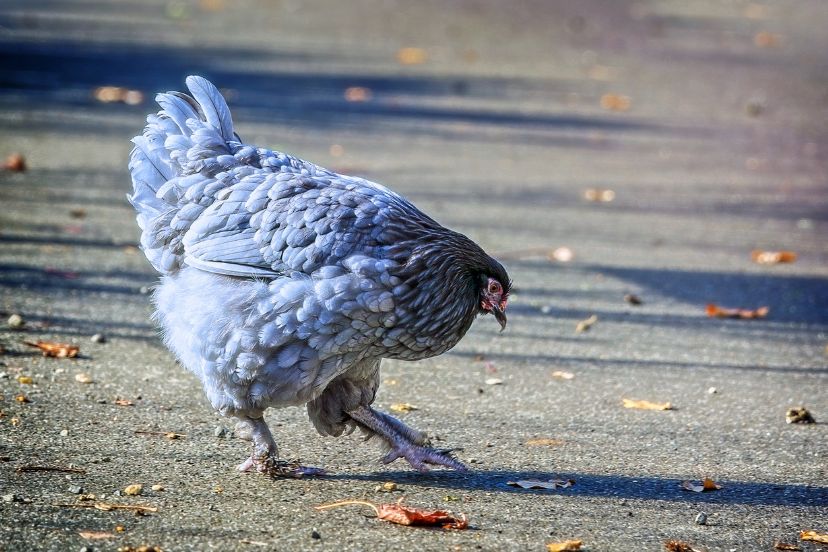Blue Chicken Breeds: More Than Just Aesthetics
Have you ever gazed into a flock of chickens and spotted a mesmerizing blue hue? No, you weren’t dreaming. Blue chicken breeds are real and they are not your average barnyard fowls. Their unique coloration is not only fascinating to bird enthusiasts but also adds a pop of color to any poultry collection. But do they offer more than just their striking looks?
The Genetics Behind Blue Feathers
Chicken genetics can be intriguing. Just like how we inherit our hair and eye colors, chickens get their feather hues from their parents. But the world of poultry genetics is a vast and colorful spectrum.
You’d be surprised to learn that the blue in blue chickens isn’t truly blue. It’s a result of specific genes diluting the black pigment, giving it a blueish appearance. A perfect analogy? Think of adding milk to your black coffee!
7 Popular Blue Chicken Breeds
There’s an array of blue chicken breeds out there. Here are some of my absolute favorites:
Blue Cochin
Among the various types of this bird, the Blue Cochin stands out. This version, while retaining its innate cuteness, carries a distinct touch of grace. Resembling plush orbs with an extra dash of class, it’s understandable why poultry enthusiasts often seek them, even though they’re somewhat rare.
Undoubtedly, these birds are heart-stealers, but when it comes to productivity, they might not top the charts. Expect around 2 eggs per week from them, amounting to roughly 100 eggs annually. However, these charming hens don’t disappoint in colder months, consistently laying when others opt for a winter rest.
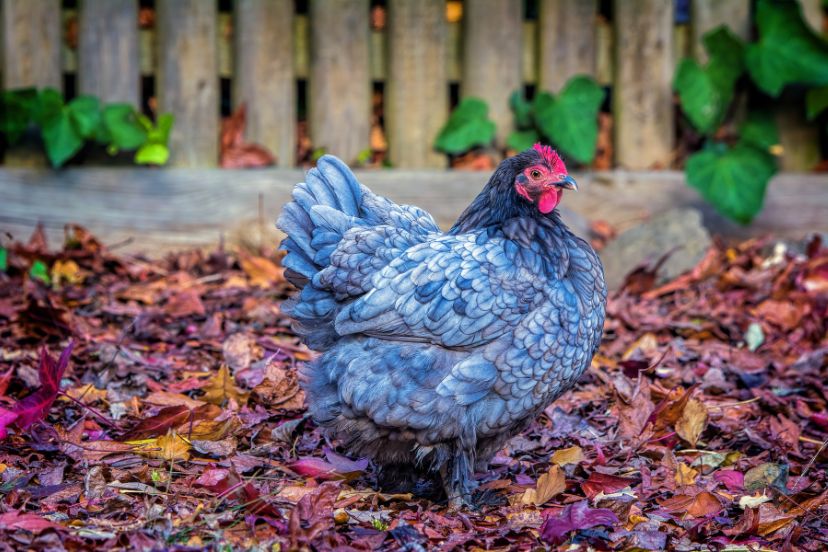
For those drawn to Cochins but desiring a touch of rarity, the Blue Cochin offers a delightful blend of allure and charm.
Lavender-Blue Orpington
Boasting a unique light lavender-blue plumage, the Lavender Orpington is a visual delight in the poultry world. This soft, pastel hue gives the bird a fairy-tale essence, setting it apart from the more common poultry shades. However, their appeal isn’t just skin deep; these chickens are known for their calm and docile nature, making them ideal for families and novice poultry keepers.
Despite their peaceful demeanor, Lavender Orpingtons are robust birds that comfortably occupy the middle of the flock’s pecking order. They adapt well to various environments and offer a decent egg yield, making them a favored choice for those seeking a blend of beauty and functionality in their coop.
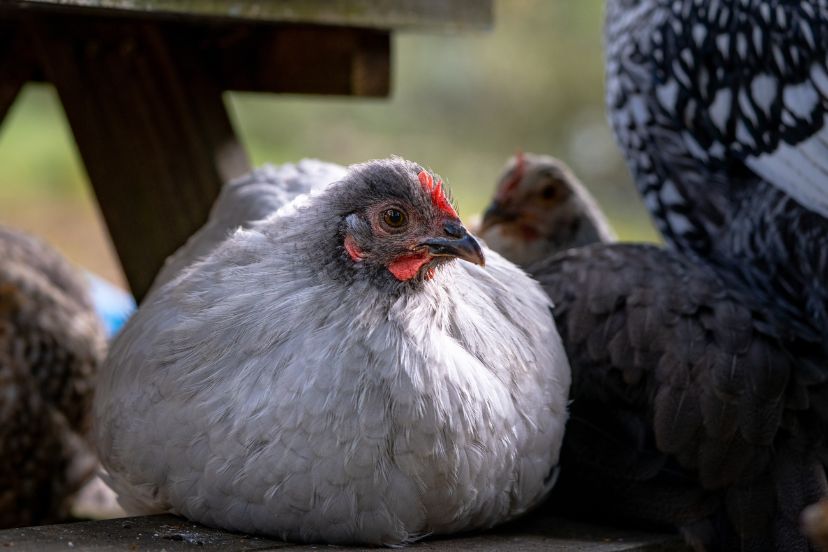
The Lavender Orpington is more than just a pretty face. It’s a blend of beauty, tranquility, and utility, making it a cherished choice for many poultry keepers.
Blue Silkie
The Blue Silkie, often dubbed the “teddy bear” of the poultry realm, stands out with its distinctively fluffy, soft plumage that feels like silk or satin to the touch. This breed’s endearing appearance is further accentuated by its blue hue, a mesmerizing color that adds depth to its already plush feathers.
Beyond their striking looks, Blue Silkies are cherished for their gentle and affectionate temperament. Their docility, combined with their unique texture and hue, makes them not only a favorite among poultry enthusiasts but also a heartwarming addition to any backyard coop.
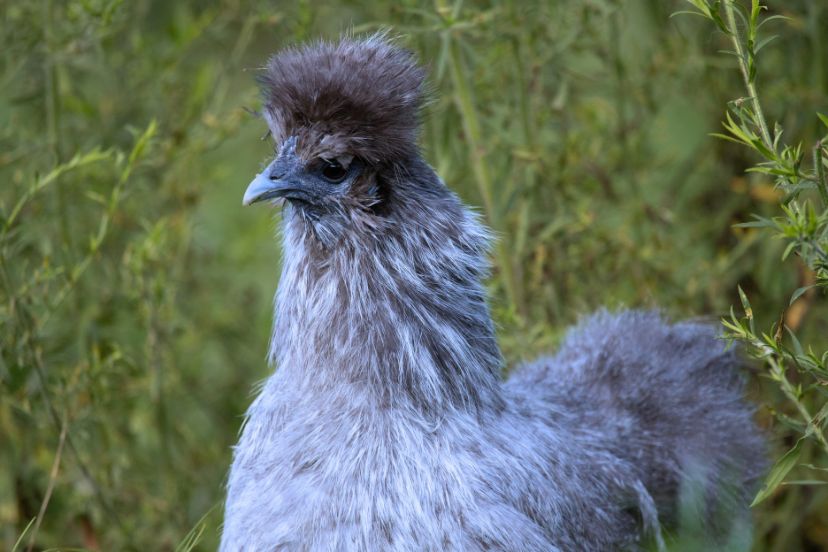
Cream Legbar
The Cream Legbar is a truly fascinating breed in the realm of poultry. Originating from Britain, this bird is best known for its striking blue feathers, which give it a distinctive appearance compared to many other chicken breeds. But what sets the Cream Legbar apart even more is its ability to lay blue eggs. This unique egg coloration has made them a sought-after breed among poultry enthusiasts and hobbyists.
While many chicken breeds lay the typical white or brown eggs, the Cream Legbar’s blue eggs add a touch of whimsy and excitement to any egg collection. The richness of the blue varies from egg to egg, but they’re consistently a delightful surprise. Moreover, this breed has an auto-sexing feature, meaning you can determine the gender of the chicks immediately after they hatch based on their feather coloring, a rarity in the chicken world.
Beyond their aesthetic appeal, Cream Legbars are known for their active and friendly nature. They are alert, good foragers, and have a relatively docile temperament. This makes them suitable for free-ranging setups and ensures they contribute both beauty and vitality to any flock.
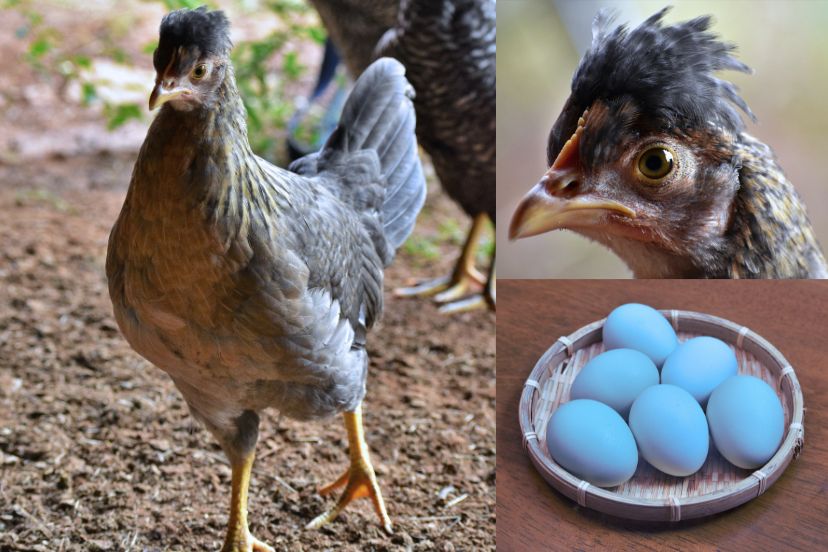
The combination of their vibrant blue feathers and equally enchanting blue eggs ensures a delightful poultry experience that’s truly “double the blue, double the fun“.
Blue Australorp
The Australorp chicken, originating from Australia’s 19th-century breed of Orpingtons, was primarily cultivated for its prolific egg production, boasting an impressive 250 eggs annually. Though this rate varies among individuals, the breed’s blue variant is particularly eye-catching. Males flaunt a deep blue on their neck, back, wings, and tail, with a paler blue underscoring their breast and underbelly, while females exhibit a light blue body with a dark-toned neck.
Initially bred for their egg-laying capabilities, Blue Australorps also present considerable meat yield, with roosters averaging 8.5-10.0 lbs and hens around 6.5-7.5 lbs. Characterized by their docile demeanor, they coexist harmoniously with humans and other coop inhabitants. However, Australorp roosters are notably vigilant, often safeguarding their flock against predators.
Read our article Blue Australorp Chickens: Origin, Characteristics, and More for further details.
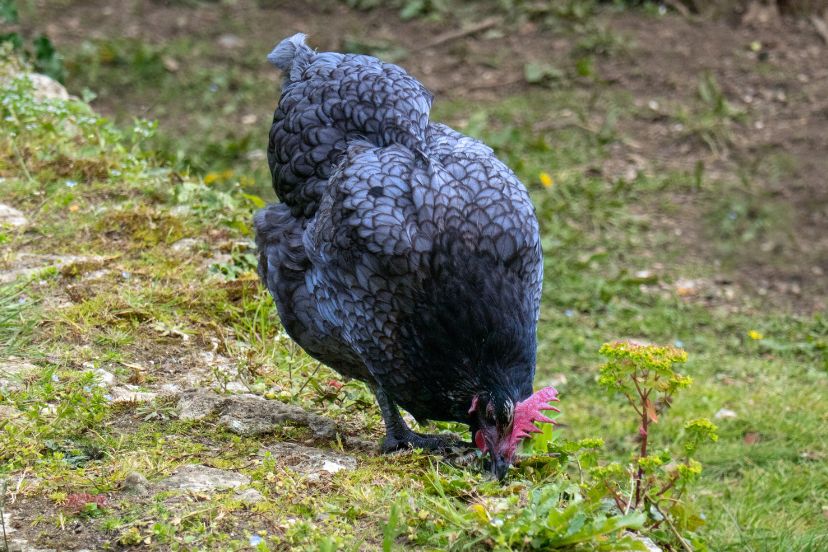
While Blue Australorps are generally resilient, their extensive egg production can occasionally result in low-quality or soft-shelled eggs, a concern remediable with calcium supplements like oyster shells.
Andalusian
The Andalusian chicken, a dazzling gem from Spain’s Andalusia region, is a blend of artistry and utility in the poultry world. Its deep blue, iridescent plumage mirrors the cerulean waters of the Mediterranean, making it a visual delight. But beyond its beauty, the Andalusian stands out as a consistent layer of large, white eggs. Active and alert, these birds are excellent foragers, combining their historical Spanish charm with robust productivity. They’re a testament to Spain’s rich fusion of aesthetics and agriculture.
Blue Plymouth Rock
The Blue Plymouth Rock, an iconic representative of American poultry heritage, blends beauty with utility. Originating from the U.S., this breed showcases captivating blue feathers ranging from light slate to deep blue, standing as a testament to selective breeding
Alongside their regal appearance, they’re celebrated for their consistency in laying large, brown eggs and their amiable nature. Their dual role as both a visual delight and a reliable egg producer epitomizes the spirit of American agricultural innovation and charm.
Caring for Your Blue Chickens
Rearing blue chickens, while similar to other poultry breeds, requires a blend of special attention and standard care practices to ensure they thrive and display their mesmerizing blue hues with pride.
Your Chicken’s Sanctuary
First and foremost, providing a spacious and safe coop is crucial. Blue chickens, with their unique plumage, benefit from having enough space to move, stretch, and flaunt their feathers. A congested coop can lead to stress, feather damage, and health issues. When designing their space, ensure there’s ample room for roosting, nesting, and play. A good rule of thumb is a minimum of 2 square feet per chicken inside the coop and 8-10 square feet in an outside run.

Vibrancy and Health
A well-balanced diet is paramount for any chicken, but for the blue breeds, it can make a significant difference in the vibrancy of their color and overall health. Quality poultry feed should be the primary source of nutrition, supplemented with grains, vegetables, and occasional treats. Additionally, providing access to grit is essential for digestion, and oyster shell supplements can be offered to layers for calcium. Remember, a healthy chicken is often a vibrant one!
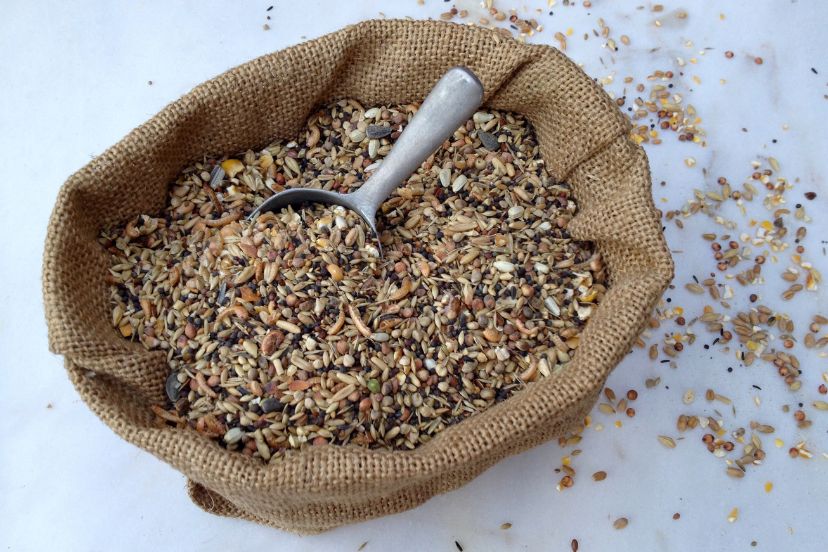
For blue chicken breeds, a balanced diet enhances their color vibrancy and health, emphasizing quality feed, grains, and essential supplements.
Introducing New Flock Members
If you’re looking to mix your blue chickens with other breeds, patience is your best ally. Introducing them slowly is the key. Start by keeping the new birds in a separate but visible area for a week or so. This ‘quarantine’ phase not only helps in monitoring the health of the new additions but also allows both parties to get accustomed to each other without direct contact. .
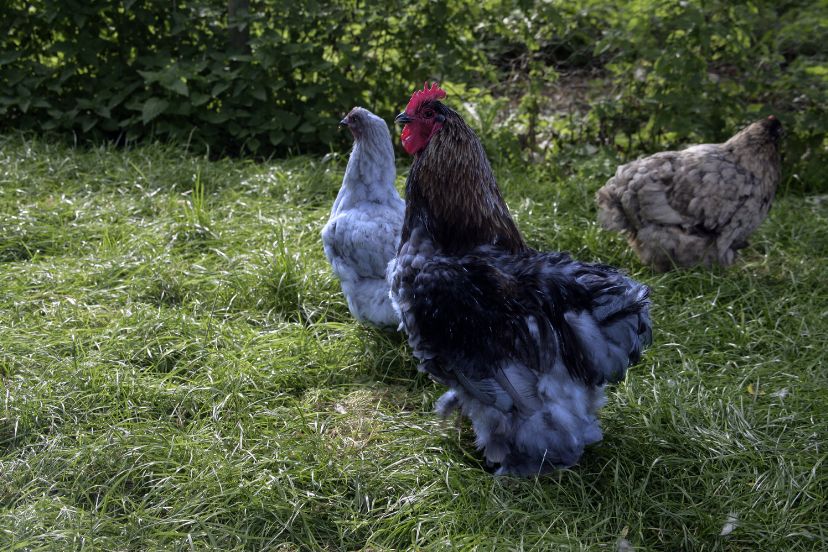
Gradual introduction minimizes stress and potential aggression, ensuring a harmonious environment in the long run
Common Challenges and Their Solutions
While blue chickens are undoubtedly captivating with their mesmerizing hue, they come with their set of challenges just like any other breed. However, with a keen eye and proactive care, most of these challenges can be efficiently managed.
Feather Health
One of the most distinctive features of blue chickens is, of course, their feathers. These are not only their crowning glory but also an indicator of their overall health.
Discoloration or dullness in their blue plumage. While some variation in shade is natural and based on genetics, a noticeable deviation or sudden dullness can be concerning.
First, ensure they’re on a balanced diet, as nutrition plays a significant role in feather health. Incorporate foods rich in protein and essential vitamins. If the diet is up to mark and the problem persists, it might be worth consulting a veterinarian. Sometimes, external parasites, stress, or underlying health issues can lead to changes in feather color and quality.
Feather pecking or loss. This can be caused by various factors including stress, boredom, or external parasites.
Regularly inspect the coop for potential stressors. This includes checking for predators, ensuring they have enough space, and providing them with adequate entertainment like perches and toys. If parasites are the culprits, regular coop cleanings and treatments can help alleviate the issue.
Difficulty in spotting dirt or parasites due to the unique color. Darker feathers can sometimes mask dirt, mites, or lice.
Implement a routine check. Gently part the feathers and inspect the skin underneath. Look for any signs of irritation, pests, or unusual spots. Keeping the coop clean and ensuring regular dust baths can also help in preventing parasite infestations.
In essence, while blue chickens don’t differ dramatically from other breeds in terms of care, their unique coloration requires a slightly more vigilant approach, especially concerning feather health. With regular checks and proactive care, these birds can continue to be the blue jewels of your coop.
FAQs
Do all blue chicken breeds lay blue eggs? Not all. While breeds like the Cream Legbar do, others might not.
Is their temperament different from other chickens? Generally, they’re calm, but temperament can vary across breeds.
Are they hard to find? Some breeds are rarer than others, but with growing popularity, many breeders now offer blue varieties.
Is their care different from regular chickens? Basic care remains the same. Just ensure a clean environment and monitor their health.
Can I mix them with other chicken breeds? Absolutely! Just introduce them slowly and monitor their interactions.

